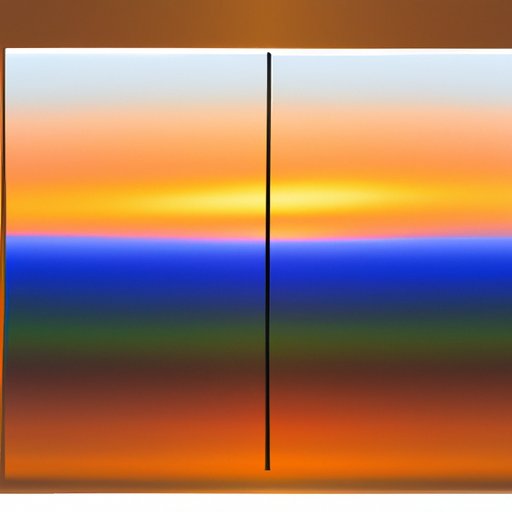Introduction
A mirage is an optical phenomenon caused by atmospheric conditions that creates the illusion of water or other objects in the distance. It is usually seen on hot days when the air near the ground is hotter than the air above it. This causes light rays to be bent and refracted, creating a distorted image of the landscape.
The purpose of this article is to explore the science behind how mirages work and to provide an overview of the different types of mirages as well as their causes and history. We will also look at how to identify a mirage in nature.
Explaining the Science Behind How Mirages Work
Mirages are created by several factors working together. The most important factor is refraction, which is the bending of light as it passes through one medium to another. This can occur when light passes from air to water, air to glass, or air to air with different temperatures. When light passes from warmer air to cooler air, it bends downward, creating an inverted image.
Another important factor is the inversion of temperature layers. When the air near the ground is hotter than the air above it, this creates a temperature inversion layer. This layer acts like a mirror and reflects light back down to the ground, creating the illusion of a pool of water or other objects in the distance.
The properties of the atmosphere also play a role in creating mirages. Dust particles, humidity, and other particles in the air can affect the refraction of light and the formation of temperature inversion layers. The angle of the sun also affects the formation of mirages, as the sun’s rays are more likely to be bent when they hit the atmosphere at an oblique angle.
An Overview of Mirage Phenomenon and Its Causes
Mirages can occur in any environment, but they are more common in desert areas and on hot days. They can also occur on cold days when the air near the ground is colder than the air above it. Common causes of mirages include temperature inversion layers, dust particles, humidity, and the angle of the sun.
Other factors that can affect the formation of mirages include wind speed and direction, atmospheric pressure, and the height of the observer. Wind can cause turbulence in the atmosphere, which can disrupt the formation of temperature inversion layers. Atmospheric pressure can make the air denser or less dense, which can also affect the formation of mirages.

Examining the Different Types of Mirages
There are several different types of mirages. The most common type is the superior mirage, which occurs when the air near the ground is hotter than the air above it. This causes light to bend downward, creating an inverted image of the landscape.
Another type of mirage is the Fata Morgana, which is a complex form of superior mirage. It is characterized by multiple images stacked on top of each other, creating a surreal effect. A looming mirage is similar to a Fata Morgana, but only one image is visible. Finally, a heating mirage is caused by the sun’s heat radiating off the ground, which can create an illusion of water or other objects.

Investigating the History of Mirage Reports
Mirages have been reported since ancient times. Early accounts describe mirages as visions of cities, ships, and other objects in the sky. These early reports were often dismissed as illusions or hallucinations, but later scientific studies confirmed that these sightings were indeed mirages.
For centuries, mariners used mirages as a navigational aid. By looking for an inverted image of the horizon, sailors could tell if they were approaching land or not. Today, mirages are still used in navigation, although modern technology has made them less necessary.
In recent years, scientists have studied mirages in detail. They have examined the physics behind mirage formation and conducted experiments to better understand the phenomenon. This research has led to a greater understanding of the science behind mirages and how they work.

A Guide to Identifying a Mirage in Nature
Identifying a mirage in nature can be tricky, but there are some key characteristics to look for. Mirages usually appear as a shimmering reflection of the sky or an object in the distance. They can also appear as a distorted, upside-down image of the landscape. In addition, mirages are usually found in areas where the air is significantly hotter than the air above it.
When looking for a mirage, it is best to use binoculars or a telescope to get a better view. It is also helpful to know the angle of the sun and the direction of the wind, as these can affect the formation of a mirage. Finally, it is important to remember that mirages can disappear quickly, so if you spot one, it is best to observe it quickly.
Conclusion
In conclusion, mirages are an interesting and mysterious phenomenon caused by the refraction of light and the inversion of temperature layers. They have been observed since ancient times and have been used in navigation for centuries. There are several different types of mirages, each with its own unique characteristics. Identifying a mirage in nature requires knowledge of the science behind it as well as an understanding of the atmospheric conditions that can affect its formation.
This article has provided an overview of how does mirage work and the various types of mirages. We have also looked at the history of mirages and provided a guide to identifying them in nature. For more information, please refer to the resources listed below.
Resources for Further Reading
Hansen, J., & Sato, M. (2017). Introduction to Optics. Elsevier.
Ludwig, E. (2020). Mirage: A Natural Phenomenon Explained. Springer.
Travis, J. (2019). Mirages: How Nature Tricks Our Eyes. University of Chicago Press.
(Note: Is this article not meeting your expectations? Do you have knowledge or insights to share? Unlock new opportunities and expand your reach by joining our authors team. Click Registration to join us and share your expertise with our readers.)
